The end of the value trade may be near as investors push prices beyond economic growth expectations.
Interestingly, it was just last year that I wrote: “The Rotation To Value Is Inevitable.” The critical point of that article was this:
“The market’s surge higher since the financial crisis, which has been driven by massive fiscal and monetary policies. It has been nothing short of extraordinary. Currently, the S&P 500 is trading at the greatest deviation from its long-term exponential growth trend in history.”
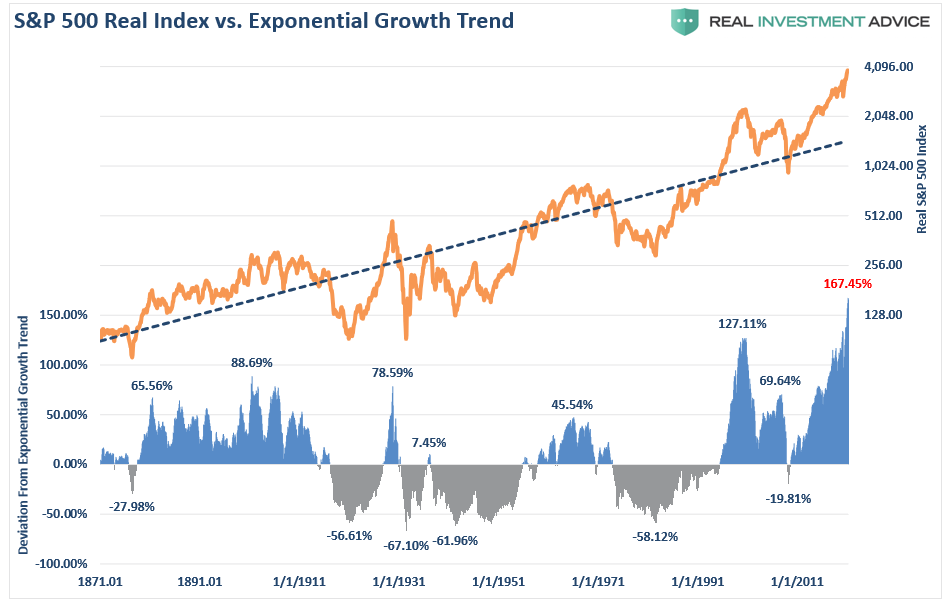
The unparalleled monetary policy use to push markets higher, massive fiscal spending designed to keep economic growth positive, and corporations shunning future growth for “share repurchases” remains the common thread.
As Michael Lebowitz, CFA, previously noted:
“As a result of these behaviors and actions, we have witnessed an anomaly that historically spelled success for investors. Stronger companies with predictable income generation and solid balance sheets have grossly underperformed those with unreliable earnings and over-burdened balance sheets. The prospect of majestic future growth has trumped dependable growth. Companies with little to no income and massive debts have been the winners.”
Such was much the same as we saw in late 1999 as companies with no earnings, no revenue, and no real strategy for growth exploded higher in a speculation-fueled buying frenzy.
Is It The “Great Rotation?”
Since the end of last year, the “value” rotation finally did get underway, with the energy sector leading the charge. Industrials, Materials, and Financials joined the advance as expectations for “infrastructure spending,” and “reopening” grew. The chart below shows sector performance relative to the S&P 500 index over the last 120-days.

Historically, when rotations to “value” have occurred, it has accompanied significant market reversions and a break of the previous “bullish” psychology. The accompanying destruction of capital pushed investors into requiring a “margin of safety.”
Such was not the case this time as investors chasing “growth” rotated to pursue the market’s laggards. In other words, as I noted this past weekend:
“With the ‘value trade’ excessively overbought and has become the recent ‘momentum’ trade, we may see a relatively rapid rotation back into recently beaten-up sectors.”

As shown below, the performance between “growth” and “value” has now inverted.

The question that we must answer is whether the rotation is sustainable in the future.
Value In Name Only
Ben Graham heavily espoused the importance of a “margin of safety” in the investment operation. The margin of safety suggests an investor only purchases securities when their market price is significantly below their intrinsic value.
Followers of Ben Graham’s teachings have a deep history of long-term investing success, from Warren Buffett to Seth Klarman:
“The best investments have a considerable margin of safety. This is Benjamin Graham’s concept of buying at a sufficient discount that even bad luck or the vicissitudes of the business cycle won’t derail an investment.” – Seth Klarman
The problem with the current “value” trade is there is very little, if any, “margin of safety” in the companies investors are piling into. As discussed in “The Astonishing Lack Of Value:”
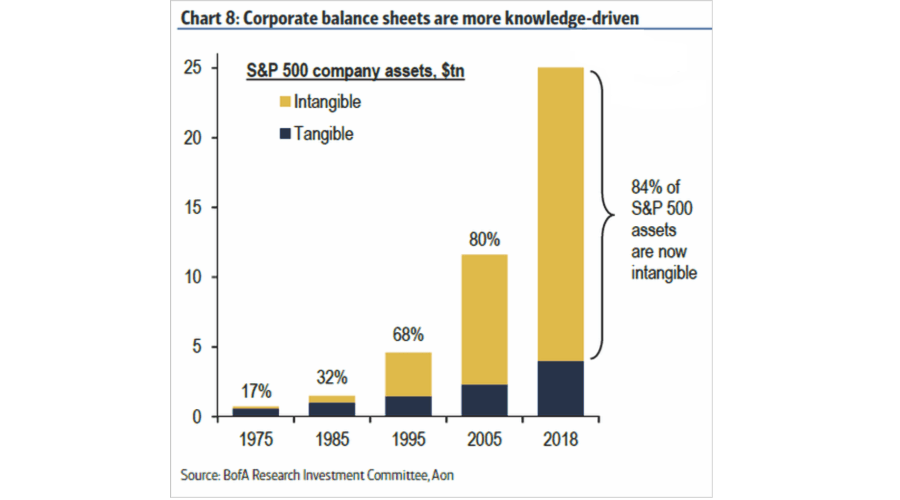
The chart is pretty stunning but needs some explanation.
Theoretically, book value represents the total amount a company is worth under a liquidation scenario. Such is the amount that the company’s creditors can expect to receive.
Book value analysis and buying companies with low “price-to-book” ratios have historically been profitable ventures. Companies with machinery, inventory, and equipment, and financial assets tend to have large book values. Significantly, these types of investments are easily valued and liquidated in the event of financial stress or bankruptcy.
However, today, as shown, such is no longer the case. With the rise in gaming, software, database, consultancies, etc., the increase in “intangible assets” has surged. Items such as patents, licenses, human capital, etc., now make up a significant portion of many company’s “value.”
These types of assets are hard to value and more difficult to liquidate. Such is especially the case with human capital or a measure of an employee’s skill set’s economic value.
The Evolution Of Intangibles
“Intangibles used to play a much smaller role than they do now, with physical assets comprising the majority of value for most enterprise companies. However, an increasingly competitive and digital economy has placed the focus on things like intellectual property, as companies race to out-innovate one another.
To measure this historical shift, Aon and the Ponemon Institute analyzed the value of intangible and tangible assets over nearly four and a half decades on the S&P 500. Here’s how they stack up:” – Visual Capitalist
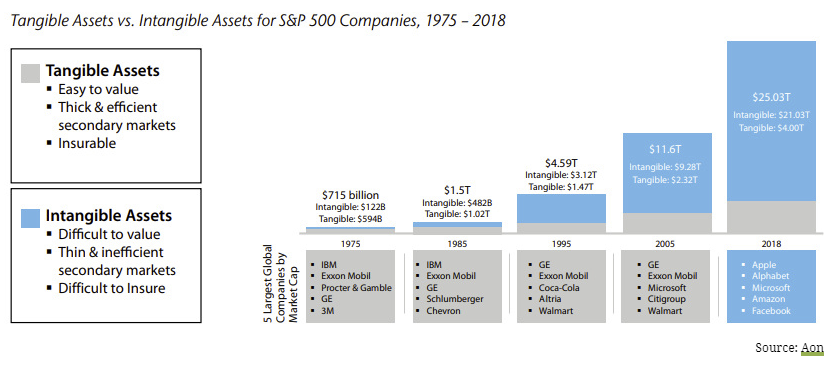
“In just 43 years, intangibles have evolved from a supporting asset into a major consideration for investors – today, they make up 84% of all enterprise value on the S&P 500, a massive increase from just 17% in 1975.
Digital-centric sectors, such as internet & software and technology & IT, are heavily reliant on intangible assets. Brand Finance, which produces an annual ranking of companies based on intangible value, has companies in these sectors taking the top five spots on the 2019 edition of their report.” – Visual Capitalist

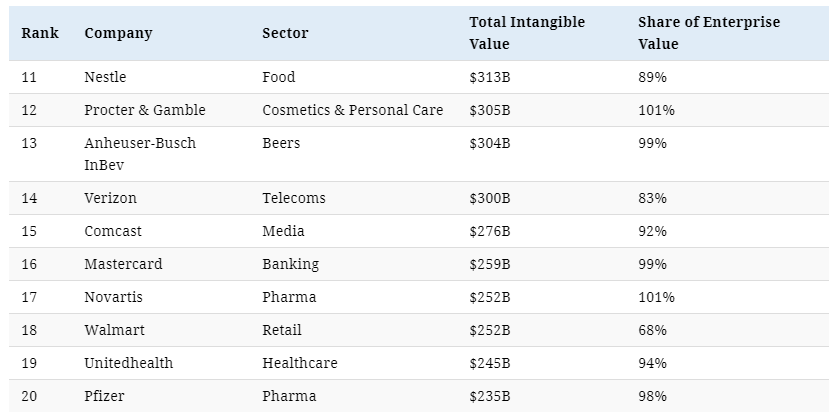
While the issues of “intangibles” should undoubtedly be a concern for “value” investors, another issue further compounding the problem. Debt and accounting gimmicks.
A Compounded Problem
As discussed previously in “EBITDA Is Bull****,“ the heavy use of accounting gimmicks is obfuscating publicly-traded companies’ actual value. As noted:
“An in-depth study by Audit Analytics revealed that 97% of companies in the S&P 500 used non-GAAP financials in 2017, up from 59% in 1996, while the average number of different non-GAAP metrics used per filing rose from 2.35 to 7.45 over two decades.
This growing divergence between the earnings calculated according to accepted accounting principles, and the ‘earnings’ touted in press releases and analyst research reports, has put investors at a disadvantage of understanding exactly what they are paying for.”
Compounding the problem of accounting issues is surging corporate debt levels, and the issue becomes more apparent. Given the Federal Reserve’s monetary injections and suppression of interest rates, companies heavily leveraged their balance sheets. As interest rates plunged, corporations issued a record amount of debt to pay dividends and increase share repurchases.

The increased leverage of corporate balance sheets is problematic, particularly given already weak revenue growth for S&P 500 companies.
Be Careful What You Wish For
While there are many expectations that further rounds of stimulus will promote a short-term pick-up in economic growth, that may also be a problem for the value trade. As noted above, the “value” trade works best coming out of a weak economy and late-stage bear markets.
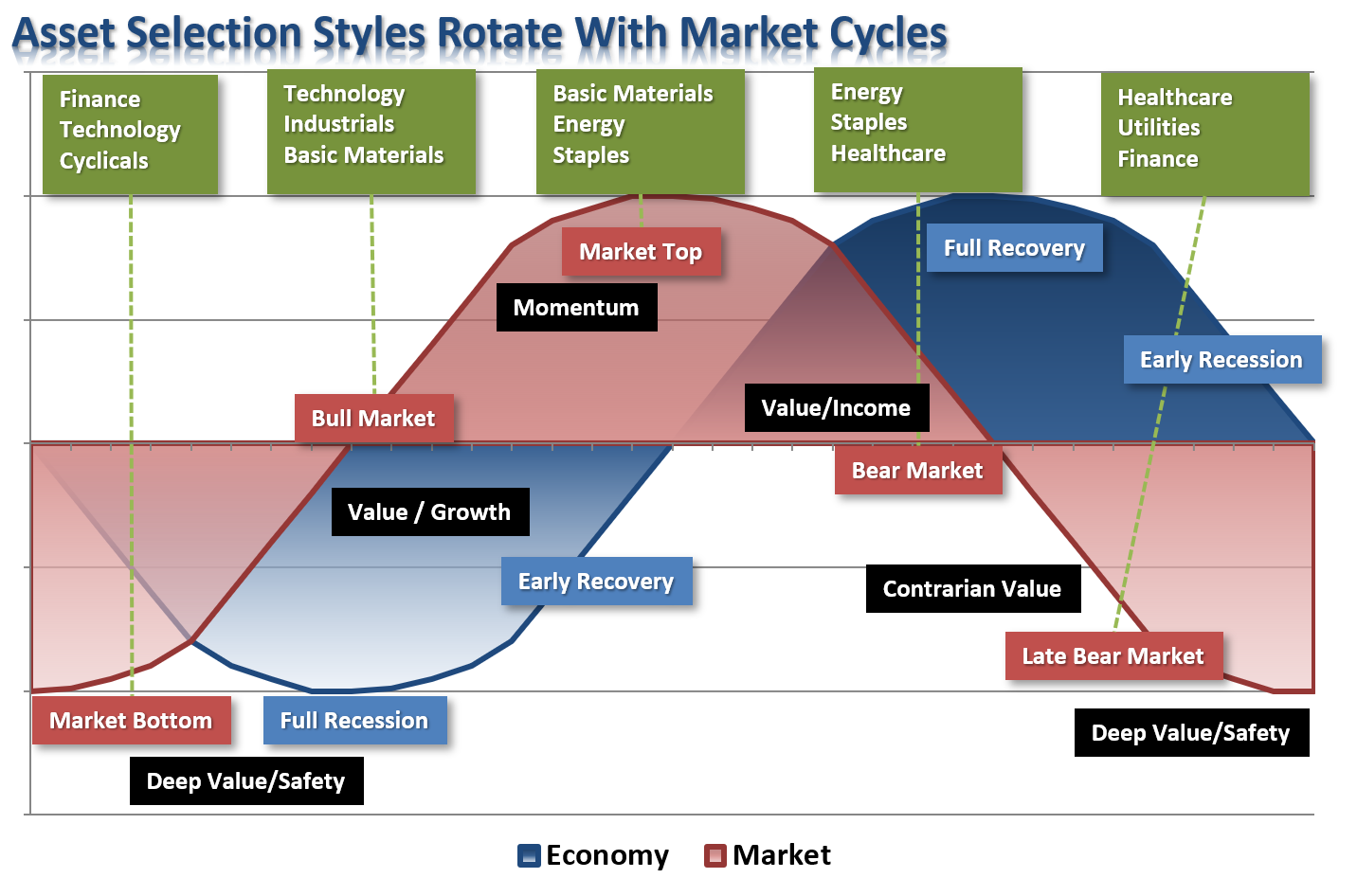
While the U.S. certainly experienced a “recession” due to a “pandemic-driven” choice to “shut-down” economic activity, the recessionary cycle was not allowed to complete the normal process of reverting valuations. As shown in the chart below, it is hard to suggest a “margin of safety” currently present.

As noted, the hope is that economic growth will rise strongly enough for earnings to catch up with prices. However, if market participants get their wish of increased economic growth, both inflation and interest rates will rise in lockstep. Such would undermine earnings growth and valuations as higher costs reduce profit margins.
The Dollar Problem
Then there is the dollar. The recent rotation to value has been primarily a function of a “weaker dollar,” which boosts commodities. As noted, if economic growth does strengthen, leading to higher rates will attract foreign inflows into the dollar for a higher yield. Such also undermines corporate profitability, given that roughly 40% of corporate profits are from abroad.
Such was a point made by JP Morgan just recently:
“The USD and yields have shifted from a negative correlation to a positive correlation, with the bank suggesting that recent USD strength may be driving some of the recent weakness in commodities.”
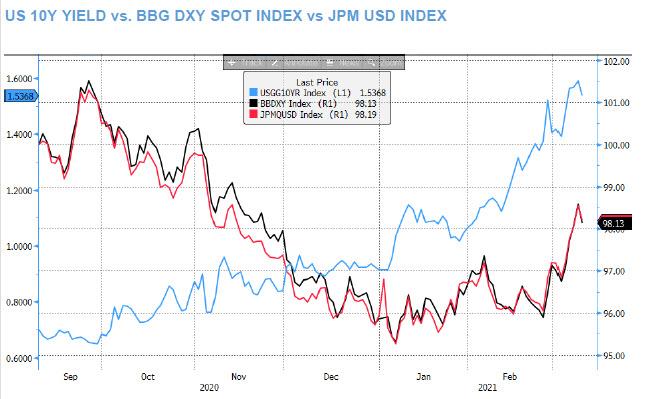
The risk not factored into the current “value” trade is the inflation and interest rate increase due to the massive amounts of stimulus. However, that stimulus will quickly flow through the system, leaving consumers tapped by higher inflation and rates eroding disposable income.
In other words, the “value trade” could be just a fleeting as the “economic recovery” itself.
No Real Correlation
As Michale Lebowitz recently penned for our RIAPRO.NET subscribers (30-day Free Trial):
“Does value beat growth in a rising yield environment?
At first blush, we would answer with a resounding yes. Our justification is value companies tend to use less leverage making profits not as sensitive to higher interest rates.
To help answer the question, we assessed nearly 100 years of data courtesy of Dartmouth (French/Fama). We created several statistical models and found no significant correlation between the value/growth trade and yields.
It turns out the task was simpler than we thought. All we needed to do was compare a value/growth index versus 10-year yields. The answer: value consistently outperforms growth, regardless of the rate environment.
The red shaded area denotes the last environment with consistently higher yields. The green period highlights the yield decline over the previous forty years. The second graph shows rolling five-year annualized returns of value versus growth.”

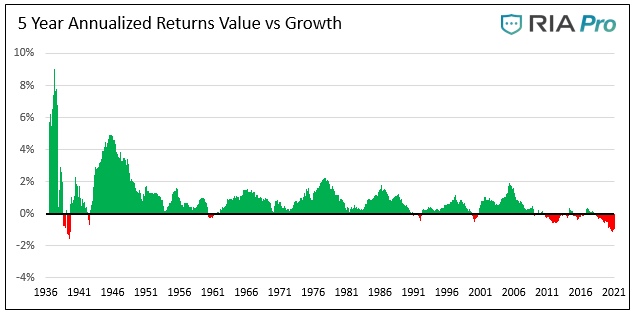
Is this time different? Maybe. As Michael notes:
“The last decade, in which growth has beaten value, is the anomaly, not the rule. Just as we started with a question, we leave you with one: are we entering a new paradigm?”
The change to the market environment resulting from the computerization of the markets, liquidity, and artificial interventions has indeed changed its functioning over the last decade. Social media and financial trading apps like “Robinhood” have changed investor’s behaviors.
Such may indeed have changed the value/growth equation as the lines between “value” and “growth” become more blurred.
A Barbell Approach
We certainly don’t profess to have all the answers, but there is no argument we will see more robust growth, rising inflationary pressures, and higher rates. Such suggests the “value trade” may persist for a while longer.
In an inflationary environment, coincident with higher rates, investors should focus on the sectors that have a low correlation with the US Dollar. Furthermore, investments should be able to generate earnings growth in a weak economic environment in the future.
Such leaves us with maintaining a barbell approach to our portfolios, with a portion of the allocation focused on value for the current environment. Those sectors remain energy, financials, industrials, and materials for now.
However, we also continue to opportunistically add to our growth sectors as economic growth will return to its 2%ish long-term trend growth. Technology, Staples, and Healthcare remain increasingly recession-proof due to the changing workforce, demographic trends, and living standards.
We are firm believers in “value investing.” However, after years of artificial interventions, accounting gimmicks, share buybacks, and massive balance sheet leveraging, there is little “real” value in the markets currently.
Given that the markets have not been allowed to reset, speculators are now simply chasing the next “momentum” trade called “value.”
For now, we have to continue to navigate markets for what they are rather than what we “hope” they could be. We suspect that this year could wind up disappointing both economists and investors alike.
Related: Is Hyperinflation Really A Threat?




